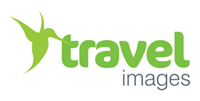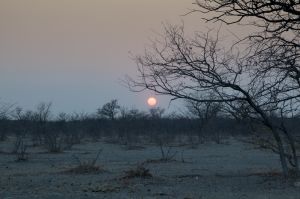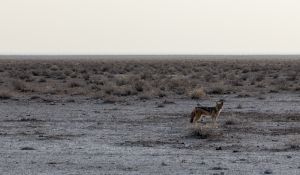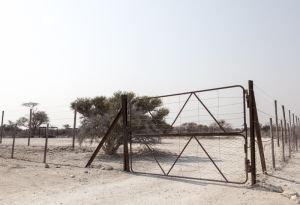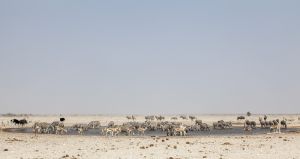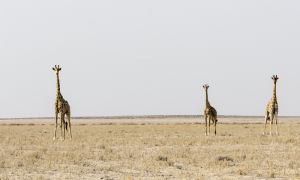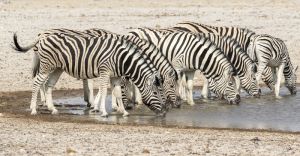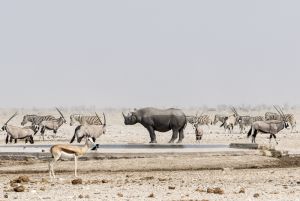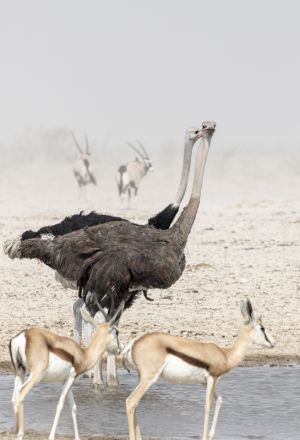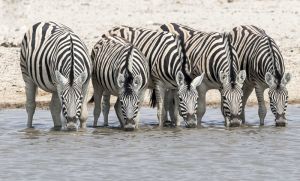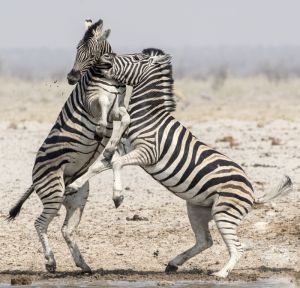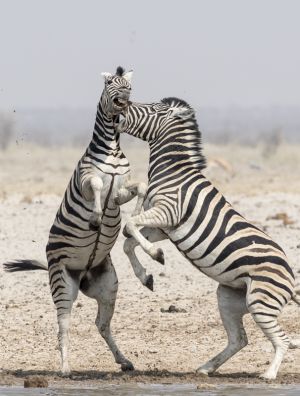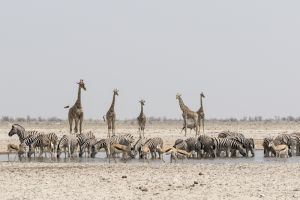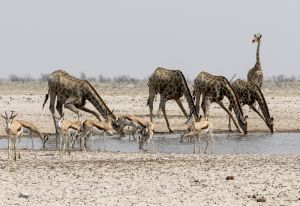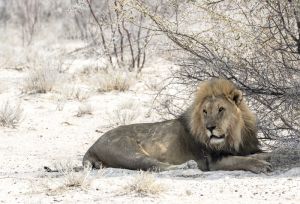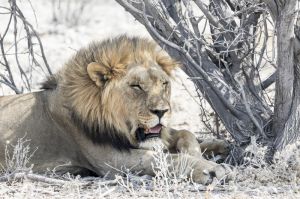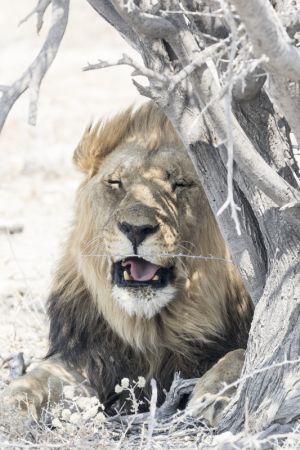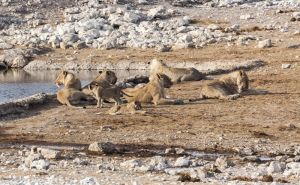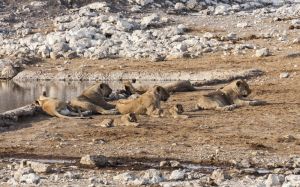The comedy of errors continues at Ongava Tented Camp when I’m woken at 5.30am for no reason. Apparently someone got it into their head that I was travelling with a couple of Brits as we arrived on the same day, and I’d therefore like to get up and go on an ‘activity’ with them. I think it goes back to check-in when my reservation was mixed in with another couple of people.
The end result is that I’m up and dressed and at my car as soon by the time the sunrises at 06:45, and have driven the 18km from the camp to the front gate of Etosha, and a further 17km to park reception by 7:10am.
I spent last night’s ‘communal dinner’ studying a map of Etosha, and reading the excellent ‘The Photographer’s Guide to Etosha National Park’. It’s a little dated in terms of equipment, but the maps and descriptions of waterholes are excellent. Based on the maps, I’ve decided to start the day at Ozonjuitji m’Bari, or m’Bari as it’s commonly known.
It’s 58km from park reception to Okaukuejo to m’Bari, and I take a circuitous route via the Okondeka and Adamax waterholes. There are very few cars about, so I’m lucky on the road to Okondeka to see a pair of jackals, and a spotted hyena hiding her cubs in a culvert.
A bathroom break along the way reveals the strategy for the management of humans in the park – make sure the humans are in a fenced area, and animals free to roam – the antithesis of a zoo. This is the picnic and toilets on the road just after the turn-off to Grunewald.
Not much is happening at Okondeka – a jackal sleeping and napping and a few springboks. I push on to m’Bari, which is teeming with wildlife. A small queue of vehicles is waiting patiently for a herd of springboks to make their unhurried way across the car park to the waterhole. I end up spending a couple of hours here, watching the passing parade of wildlife – black rhino, sparring zebra stallions, ostriches, herd after herd after herd of zebras, springboks, and wildebeest.
I’ve been watching four giraffe way off across the road – by their body language they’ve spotted something in the dunes about the waterhole. Sure enough, an hour later a herd of zebra up near the road alerts and takes off at a rapid clip. Through the binoculars I can see what I suspected was there – a large male lion has gotten up in the dunes and started walking away from the waterhole, towards the road. He’s an old guy judging by his teeth, and picks the only bit of shade available under a tree – it’s 37 degrees Celsius.
Hunger ultimately drives me away from m’Bari and back to Okaukuejo for food and fuel. A short buffet lunch at the restaurant attached to the accommodation provided in the park shows what good value the park entry fee is – lunch is 50% more for chicken, rice and a sparkling mineral water than a day’s entrance fee for one person and one vehicle.
In the afternoon, it’s a toss up between heading back to m’Bari or a circuit of the south western waterholes. I opt for the south western waterholes, which pays dividends when I find a mated pair – lion and lioness – resting under a thorn bush on the side of the main road to Halali. The lioness isn’t really visible under the thorn bush as the male is blocking the view with his body.
I think 3 lions is a good sighting in one day until I reach Olifantsbad waterhole, which is usually busy with elephants, hence the name. It’s quiet at the waterhole, which usually means that there are predators around. The binoculars are invaluable at spotting another 4 lions, including a male, resting under the shade of the bushes above the waterhole. 7 lions is a pretty good haul, but these four will probably stay in the shade until it cools off a little later in the afternoon, so I press on to Aus waterhole. Not much happening there – a solo giraffe spends a long time looking around to see if it is safe to drink.
I head back to Olifantsbad to see if anything has changed, and soon realise that I can’t count. There aren’t four lions resting in the shade, there are 11, including 2 small cubs. At 5pm, it is the cubs demanding a drink from the waterhole that forces the whole pride down to the waterhole. First the two cubs, closely followed by their mother, then a series of sub-adult and adult lionesses, and finally the male. It is a spectacular sighting, and only the need to be out of the park by 18:50 forces me to leave at 17:30.
[embedplusvideo height=”480″ width=”800″ editlink=”http://bit.ly/1isicPE” standard=”http://www.youtube.com/v/saAxr_64gf8?fs=1&vq=hd720″ vars=”ytid=saAxr_64gf8&width=800&height=480&start=&stop=&rs=w&hd=1&autoplay=0&react=0&chapters=¬es=&lean=1″ id=”ep4538″ /]
[embedplusvideo height=”480″ width=”800″ editlink=”http://bit.ly/1GQsvsx” standard=”http://www.youtube.com/v/gSVd_0lhCD0?fs=1&vq=hd720″ vars=”ytid=gSVd_0lhCD0&width=800&height=480&start=&stop=&rs=w&hd=1&autoplay=0&react=0&chapters=¬es=&lean=1″ id=”ep2233″ /]
[embedplusvideo height=”480″ width=”800″ editlink=”http://bit.ly/1XGobAv” standard=”http://www.youtube.com/v/-2yBXqfnKWE?fs=1&vq=hd720″ vars=”ytid=-2yBXqfnKWE&width=800&height=480&start=&stop=&rs=w&hd=1&autoplay=0&react=0&chapters=¬es=&lean=1″ id=”ep3818″ /]
If I was going to do this again, I’d stay 2 nights at Onguma Tented Camp, and use it as a base for the eastern sector of the park, 1 or 2 nights at the park chalets at Halali, 2 nights at Okaukuejo in the park accommodation, and 1 or 2 nights at Dolomite rest camp in the far north-west of the park. I’d skip Ongava tented camp altogether, and head to my next destination from Etosha itself.
